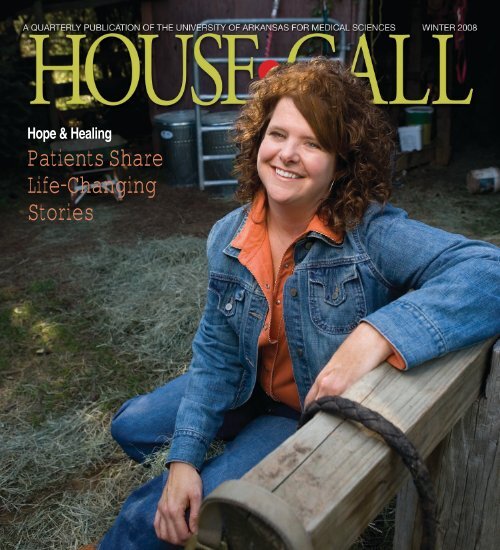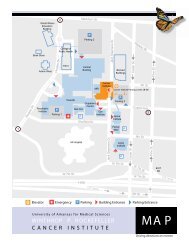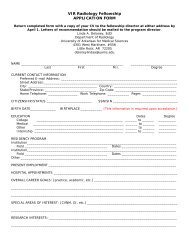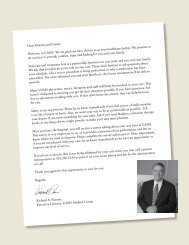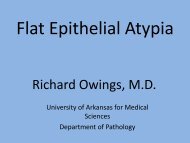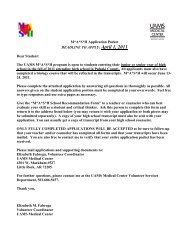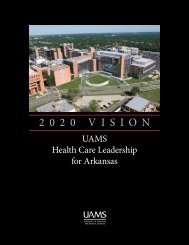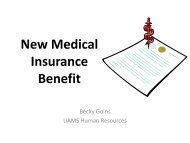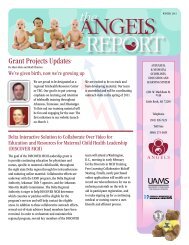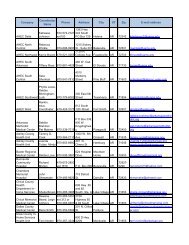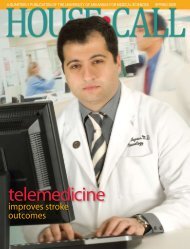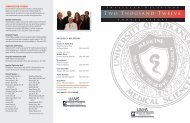Patients Share Life-Changing Stories - UAMS Medical Center
Patients Share Life-Changing Stories - UAMS Medical Center
Patients Share Life-Changing Stories - UAMS Medical Center
- No tags were found...
Create successful ePaper yourself
Turn your PDF publications into a flip-book with our unique Google optimized e-Paper software.
Hope & Healing<strong>Patients</strong> <strong>Share</strong><strong>Life</strong>-<strong>Changing</strong><strong>Stories</strong>
Johnpaul Jonescontentswinter 200841012Full of PossibilitiesSix <strong>UAMS</strong> patients share their inspirational storiesof hope and healing.Launching a SatelliteThe state’s need for additional health care providershas prompted <strong>UAMS</strong> to begin plans for a northwestArkansas campus.A Good Hair DayTwo College of Nursing faculty members donate theirhair to benefit others.in every issue3 The Chancellor’s Corner13 Healers Nurse’s career bringsunexpected opportunities14 Did You Know?16 Builders Mental health resources havea new home18 Scholars Dual degree programs offeradvantages for students19 Partners Entergy Arkansas CEOshares his talents with <strong>UAMS</strong>On the cover: <strong>UAMS</strong> patient Karen Howlett at her horsestable near Conway.Cover photo by Michael Pirnique.page 92 HOUSE • CALL
HOUSE•CALLwinter 2008editorSusan Van Dusenart directorlaurie Shellmanaging editorliz Caldwellcreative directorKeith Runklewritersliz CaldwellJon ParhamDavid RobinsonSusan Van DusenphotographerJohnpaul Joneseditorial advisory boardKathy AlexanderJerry AtchleyAnne BynumCindy PughDale RonnelCarla SpainhourJudy SnowdenBecky TuckerchancellorDr. I. Dodd Wilsonvice chancellor ofcommunications and marketingPat Torvestadassociate vice chancellor ofcommunications and marketingleslie Taylorassistant vice chancellor ofcommunications and marketingTim IrbyHouseCall is published quarterly by the<strong>UAMS</strong> Office of Communications and Marketing4301 W. Markham St. #890, little Rock, AR 72205-7199Phone: (501) 686-5686 Fax: (501) 686-6020Visit us online at www.uams.edu/housecall.Celebrating SuccessThe vision of <strong>UAMS</strong> is in providing fora healthier Arkansas. An essential part ofthis vision lies in our patient care mission,as well as in educating our future health careproviders.The quality of our patient care is closelylinked to the quality of our education,research and outreach. As the state’s onlycomprehensive academic health center,<strong>UAMS</strong> is uniquely positioned to treat peoplewith complex medical conditions, as wellas those in need of basic primary care. Ourdoctors, nurses and other staff members areintensely dedicated to offering the finest, mosttechnologically advanced treatments available.In this issue of HouseCall, we focus onpatient success stories. There are countlessstories we could have told, but the six patientswe chose represent the broad scope of careavailable at <strong>UAMS</strong>. Whether they personallymade the decision to receive treatment atchancellor’s corner<strong>UAMS</strong> or were brought heredue to a medical crisis, each ofthese patients openly expressesgratitude for the compassionatecare offered by <strong>UAMS</strong>’ staff.One of the stories we shareis that of Ambra Jackson andher brother, Bryan Clay. Likethousands of other Americans,Ambra and Bryan live withmultiple sclerosis, an illness forwhich there is not yet a cure. Yetthese young people epitomizethe strength and conviction that— with the help of their healthcare team — they can live life tothe fullest.It is truly our hope for allArkansans that through researchand treatment, life can be notonly extended but also enhanced.Many of our research programs,including the internationallyrecognized Myeloma Institute forResearch and Therapy, make this goal a realityevery day.Thanks to the dedication of the institute’sdirector, Dr. Bart Barlogie, and his fellowscientists, myeloma patients at <strong>UAMS</strong> haveachieved a median survival rate of sevenyears. In 2001, the National Cancer Institutereported the national five-year survival rate formyeloma patients was only 34 percent.Other programs at <strong>UAMS</strong> are offering thesame kind of hope for people facing a widearray of illnesses and medical conditions. Ihope that you will share in our celebration ofpast successes and join us in recognizing theunlimited possibilities that the future of healthcare holds for us all.JOHNPAUl JONESI. Dodd Wilson, M.D.Chancellor, University of Arkansas for<strong>Medical</strong> SciencesHOUSE • CALL 3
Full of PossibilitiesSix <strong>UAMS</strong> <strong>Patients</strong> <strong>Share</strong> Their <strong>Stories</strong> of Hope and HealingWhile no one would choose an illness or injury, the choice is often made for us. Complex and serious conditionsrequire not only highly trained physicians, but also the latest technological advances and a compassionate careteam that understands your specific needs.On the following pages are the stories of six Arkansans who arrived at <strong>UAMS</strong> facing extraordinary medicalconditions. Some still face challenges, while others have beaten the odds. However, they all tell a similar story— that the care they received at <strong>UAMS</strong> made it possible for them to experience healing and wholeness.4 HOUSE • CALL
Karen HowlettConway<strong>UAMS</strong> High-riskPregnancy Program1Harvey and Bernice JonesEye InstituteWhen Karen Howlett counts her blessings, she starts withthe three most dear: her daughter, her son and her vision. Shewouldn’t have any of them, she said, without <strong>UAMS</strong>.Diagnosed with Marfan’s syndrome at age 5, Howlett’sparents knew she faced a life of challenges. Marfan’s syndrome is agenetic condition that affects the body’s connective tissue and cancause multiple medical conditions, including dislocated lenses andcomplications in pregnancy.Although her vision began to deteriorate at an early age,Howlett developed a love of horseback riding, competing in bothbarrel racing and pole bending events. “I knocked down a lot ofpoles because of my vision problems,” she said.As an adult, Howlett’s vision continued to decline, resultingin her sometimes resorting to wearing contact lenses and glasses atthe same time. “Because my vision was so poor, I was afraid to stayalone overnight. I eventually had to stop driving, which was reallydifficult for a 34-year-old to accept,” she said.At the same time Howlett was struggling with her vision,she was advised not to have children due to possible heart-related complications from Marfan’s. When Howlett becameunexpectedly pregnant in 2000, she and her husband, Lew, soughtthe care of Dr. Paul Wendel, a maternal-fetal medicine specialist inthe <strong>UAMS</strong> high-risk pregnancy program. <strong>UAMS</strong> is home to theonly board-certified maternal-fetal specialists in Arkansas.Under Wendel’s care, Howlett successfully delivered herdaughter, Jessica, who was followed two years later by the plannedpregnancy of her brother, Justin.“Dr. Wendel believed in me and made sure I received the bestpossible care during my pregnancies. My children were my firsttwo blessings,” Howlett said.Howlett’s third blessing came in the form of a visit to Dr.Nicola Kim at the <strong>UAMS</strong> Harvey and Bernice Jones Eye Institute.Under the care of <strong>UAMS</strong> ophthalmologist Dr. Richard Harpersince the early 1990s, Howlett was told in late 2006 that her eyeshad reached the point that she eligible for a surgical procedure thatcould potentially improve her vision.Kim performed three procedures on Howlett — a lasertreatment on her left eye and a lens implementation in both eyes— bringing her vision to a near perfect 20/25.MICHAEl PIRNIQUE(Facing page) Karen and lew Howlett with son Justin and daughter Jessica.(Above) Thanks to her eye surgery, Howlett enjoys horseback riding again.“The first time I looked at my children after my surgery, my heartmelted. It was like seeing them for the first time,” she said. “I could seeeverything, even the specks of color in their eyes. A whole new world wasopened up for me.”HOUSE • CALL 5
Frank WilliamsLittle Rock<strong>UAMS</strong> Department ofNeurosurgeryWinthrop P. RockefellerCancer Institute2JOHNPAUl JONESFrank Williams is getting back to his normal activities following successful brain surgery.On the morning of March 8, 2006, Frank Williams appeared tobe the picture of good health. An avid golfer, Williams also enjoyedbicycling and weight lifting. And — at only 46 — he showed no signsof slowing down.However, that very same night, Williams’ life took an unexpectedturn. While getting ready for bed, he experienced a seizure and lostconsciousness. His wife, Rhonda, called 911, and what followed took theirlives down a path they never imagined.“After they ran some tests, the doctor came in and told me that Ihad a brain tumor,” Williams said. The doctor informed him that whilethe tumor was probably benign, it was deeply embedded and definitelyinoperable. He was prescribed seizure medication and discharged.Fortunately for Williams, a friend recommended that he get a secondopinion from Dr. M. Gazi Yasargil, professor of neurosurgery at <strong>UAMS</strong>.Internationally recognized for his expertise in disorders of the brain andcentral nervous system, Yasargil was named Neurosurgeon of the Centuryin 1999.After reviewing his condition, Yasargil told Williams exactly whathe hoped to hear. “Dr. Yasargil said that he felt sure he could remove thetumor and that I could lead a normal life. It felt like a miracle to hearthose words,” Williams said.Yasargil successfully removed the tumor on April 4, but in the processmade the unexpected discovery that it was a moderate grade tumor thatwould require radiation and chemotherapy.Now, almost two years later, Williams is getting back to a normalroutine and enjoying time with his friends and family. “I’m still taking iteasy,” he said. “I don’t get to work or exercise the way I used to, but I’mjust so happy to be here.”He hopes his experience will help others see the value of secondopinions. “Don’t ever give up. If you’re not happy with a diagnosis or aprognosis, don’t stop until you’ve exhausted all of your options,” he said. “Ican’t thank <strong>UAMS</strong> enough for giving me the chance to keep on living andloving my wife and kids.”6 HOUSE • CALL
Bruce BellConwayJackson T. Stephens Spine& Neurosciences Institute3Bruce Bell is proof that a person’s life canchange in an instant.While applying weather-proofing material tothe ceiling of a building in Pine Bluff, Bell fell 20feet, landing on his back. No one witnessed hisfall, and it is estimated that it took his employeesabout 10 minutes to find him. “I wasn’tbreathing, and my lips and hands were blue,”Bell said.He was taken to a local hospital, wheredoctors quickly determined he should betransported to <strong>UAMS</strong> — a move he believessaved his life. “I couldn’t have picked any betterpeople to take care of me,” he said.Bell’s injuries included a broken neckand a dislocation of the base of his skull andcervical spine. A very low percentage of peoplesurvive such an injury, and those who do oftenexperience severe brain damage as a result.Dr. T. Glenn Pait, director of the <strong>UAMS</strong>Jackson T. Stephens Spine & NeurosciencesInstitute and professor of neurosurgery andorthopaedic surgery, performed the delicatesurgery to reattach Bell’s skull to his spine. “Mycondition was pretty grim,” Bell said. “I was soblessed to have Dr. Pait. He took excellent careof both me and my family.”Under the supervision of Dr. ThomasKiser, now an associate professor in the<strong>UAMS</strong> Department of Physical Medicine andRehabilitation, Bell underwent inpatient physicaland occupational therapy for about two months.Within six months he went from being unable tomove to talking and walking with assistance.Nine years later, Bell’s favorite activity isspending time with his wife and three kids. Heeven hopes one day to run a 5K.“It was a complicated injury, but everyonealways remained positive that I would recover,”he said. “You have to keep fighting.”JOHNPAUl JONESAfter a serious injury, Bruce Bell was taken to <strong>UAMS</strong>. It was a move that he believes saved his life.HOUSE • CALL 7
Ambra JacksonBryan ClayNorth Little Rock45<strong>UAMS</strong> Departmentof NeurologyBrother and sister Ambra Jackson and BryanClay share more than just the normal siblingbonds. They also share the challenges that comewith a diagnosis of multiple sclerosis (MS).Jackson first noticed a problem in 2001when she began experiencing blurred and doublevision, as well as numbness in her feet. “I didn’treally pay much attention to it, because it seemedto go back to normal,” said Jackson, who was 19at the time.However, when Jackson’s blurred visionreturned a few months later, it didn’t go away.An athlete at Philander Smith College, she hadto quit the basketball team. Her eye doctorsent her for an MRI, which showed significantneurological damage.“When they told me I had MS, I didn’teven know what that was,” she said. “It was sounreal.”MS is a disease in which the body’s immunesystem mistakenly attacks normal tissue,resulting in a loss of muscle control, numbness,difficulty with balance and vision problems.For Ambra, MS progressed quickly, puttingher in a wheelchair and forcing her to drop outof college. “I would fall because I would losemy balance and because my feet were numb,”she said. “The first time I saw Dr. Lee Archer Iwas in the wheelchair, and we didn’t know if Iwould walk again.”Archer, associate professor in the <strong>UAMS</strong>College of Medicine’s Department ofNeurology, started Ambra on chemotherapyand medication, and soon she surprised everyone by walking unassisted.“The treatments I received at <strong>UAMS</strong> really turned me around,” saidAmbra, who has since re-enrolled in college and hopes to become arehabilitation counselor to help other people experiencing similarmedical challenges.One of those people is Clay, her younger brother by four years. Afterexperiencing headaches and problems with balance, Clay was diagnosed88HOUSEHOUSE• CALL• CALLJOHNPAUl JONESSiblings Bryan Clay and Ambra Jackson enjoy playing cards and spending time together.with MS in 2004 and also is Archer’s patient. “We take it one step at atime,” said Clay, whose condition has stabilized thanks to regular infusiontreatments and medication.Together, Jackson and Clay give credit to their mom and Archer fortheir unending support. “During the hard times, our mother has been ourstrength when we are weak,” Clay said. “And Dr. Archer is the best. Of allthe doctors I’ve ever seen, he cares the most.”
Suzanne HollandMaumelleWinthrop P. RockefellerCancer Institute6JOHNPAUlSuzanne Holland hopes to use her cancer experience to help other women.JONESSuzanne Holland doesn’t shy away from a challenge. From ridingmountain bikes to four wheelers, Holland enjoys every opportunity to testher limits. So when an ovarian cancer diagnosis sidelined her in January2007, she was ready to face it head-on.“My prayer through this whole thing has been, ‘God, how did I gethere, and what am I supposed to do with this?’” she said.A 26-year <strong>UAMS</strong> employee, Holland discovered a suspicious lump inher abdomen after falling on a tile floor. A series of tests revealed a mass onher left ovary. “I believe that the beginning of my miracle was when I fell.It helped me find the cancer very early,” she said.Holland got an appointment with Dr. Alexander Burnett, director ofthe <strong>UAMS</strong> Division of Gynecological Oncology, who performed surgeryin late March 2007 to remove a very aggressive and rare form of ovariancancer. She can’t say enough to praise Burnett, his staff and the care shereceived. “I knew I had Dr. Burnett’s undivided attention, and I neededthat. I felt like my medical team was right there with me 24/7,” she said.After six rounds of chemotherapy, Holland is now ready to resumeher favorite outdoor pastimes. She’s also working with her daughter, AmyLasseigne, to share the news that ovarian cancer can be beat.“I want to use this experience to help other women,” she said.Whether that includes speaking publicly about the disease or organizingefforts to support other cancer patients and survivors, Holland is open towhatever the future holds. “If we’re on the right path, we’ll see the fruits ofour labor,” she said.HOUSEHOUSE• CALL• CALL99
lAUNCHINg ASATEllITETo MeeT The Need for MorehealTh Care Providers,UaMs looks NorThDr. Peter Kohler knowswhat <strong>UAMS</strong> needs toestablish its plannedsatellite campus.“I tell everyone that all we needare three F’s and an A,” he said.By that he means faculty, facility,funding and accreditation.Kohler, <strong>UAMS</strong>’ vice chancellorfor northwest Arkansas, is nowspearheading the drive to havestudents on a <strong>UAMS</strong> campus inFayetteville starting in 2010-2011.So far, his work has involvedmeeting with community groups,local health care providers andmany others to see how <strong>UAMS</strong> canopen a regional campus that wouldallow its Colleges of Medicine,Nursing and Pharmacy, along withsome of its allied health programs,to add more students.With more than 30 years inadministration at academic healthcenters, you might think Kohlerhimself would be ready to enjoyretirement. Instead, after 18 yearsas president of Oregon Health &Science University, he opted to diveinto the task of helping <strong>UAMS</strong>with its satellite campus plans.“I like the challenge, and thisis an extremely important project,”Kohler said. “It is critical that weexpand the pipeline for producingmore health care professionals.”Quality ProgramsThe programs intended for the<strong>UAMS</strong> satellite campus anticipatebetween 250 and 300 students,including resident physicians,when full enrollment is reached.Arkansas, like the nation, is alreadyfacing shortages of nurses andother health care professionals.Those shortages are expected togrow in the next 10 to 20 yearsas the baby boomer generationreaches retirement age and demandfor health care rises with thegrowing elderly population.The student body would likelyinclude third- and fourth-yearmedical and pharmacy students;students in graduate nursingprograms; and students in theallied health programs of radiologicimaging sciences, diagnosticmedical sonography, healthinformation management, medicaltechnology and respiratory care.<strong>UAMS</strong> is looking at the oldWashington Regional <strong>Medical</strong><strong>Center</strong> building as a home for thesatellite campus and the existingArea Health Education <strong>Center</strong>(AHEC). That hospital will finishmoving to new facilities in mid2008, Kohler said, at which timehe hopes renovations could beginto create classrooms, labs and othercampus needs.“For medical education, weneed not just conference roomsbut hospitals, medical clinics andpharmacies willing to host ourstudents for real-world experience,”Kohler said.Improving AccessCreation of a regional campuswill require startup funds tocover facility renovation andadministrative costs, along withcontinuing operational funding.<strong>UAMS</strong> anticipates using acombination of sources includingthe clinical sites, local, stateand federal governments andphilanthropy.<strong>UAMS</strong> also must weave its waythrough the varied requirements forall of the programs to inhabit thesatellite. Each profession has its own3check it outset of notification and accreditationrequirements for programs.For its satellite campus, <strong>UAMS</strong>plans to expand its medical residencyprograms in five core areas: internalmedicine, obstetrics/gynecology,pediatrics, psychiatry and surgery,in addition to a family medicineprogram that already exists inthe <strong>UAMS</strong> AHEC program.Accreditation Council for Graduate<strong>Medical</strong> Education approval wouldbe necessary for each program beforenew residents could be accepted —which means separate requirementsand timelines in each specialty.Ultimately, Kohler said, thebenefits of a regional campusinclude improving access to healthcare in the region and increasingthe number of new health careprofessionals practicing in Arkansas.“Most of the region’s hospitals havealready signed on to host <strong>UAMS</strong>resident physicians.” he said. “We’reoff to a good start.”Between 2007 and 2030, overall population in the Fayetteville-Springdale-Rogers area is expected to grow by 67 percent,compared to 24 percent growth in the little Rock area.10 HOUSE • CALL
Coming HomeWhen Dr. Peter Kohlerarrived in Arkansas, hewas already on familiarground. Recently namedthe <strong>UAMS</strong> vice chancellorfor northwest Arkansas,Kohler’s career includesnine years — from 1977-1986 — when he servedas chairman of the <strong>UAMS</strong>Department of InternalMedicine. Two of his fourchildren and four of hiseight grandchildren alsolive in the state.At his retirement fromOregon Health & ScienceUniversity (OHSU), Kohlerwas one of the longestserving presidents at anacademic medical centerin the United States. Arecent facilities expansionon the OHSU campusincluded the 335,000-square-foot Peter O.Kohler Pavilion, withadditional outpatient andinpatient capacity.JOHNPAUl JONESHOUSE • CALL 11
A good Hair DayTwo Faculty Members Donate Their Hair to Help OthersThe cancer patient was young, and she was about to lose herdistinctive red hair to chemotherapy.Dr. Claudia Barone happened to be talking to herat <strong>UAMS</strong>’ Winthrop P. Rockefeller Cancer Institute, and eachremarked at the similarities in their hair color.“She said, ‘Have you ever thought about growing your hair outand donating it for wigs for people like me?’” recalled Barone, addingthat the idea hadn’t occurred to her until then.“When I got back to my office, I decided then and there that Iwould commit to growing my hair,” said Barone, dean of the <strong>UAMS</strong>College of Nursing.That was two years ago.On Oct. 19, 2007, the day before the Komen Race for the Cure,Barone went to her salon. By happenstance, Barone was joined byKimberly Morton, also a Collegeof Nursing faculty member,who had grown her hair todonate. Barone hadn’t beenaware of Morton’s plansuntil several weeks beforewhen she expressed heramazement at Morton’slong hair.Because they bothalso happen to use thesame salon and were closeto making their donations, Baronesuggested that the two do so the day before theRace for the Cure.After her hair was washed, dried and put in a ponytail, Baroneasked the stylist for “one last look” at her waist-length hair before heshortened it to about her shoulder blades. “Yea!” she said when herstylist held up the eight-inch lock.The cut hair was bound with an elastic band at one end and putin a zipper-lock bag. Barone said her next stop was the post office,where she mailed it to Pantene’s Beautiful Lengths, which makes realhairwigs for adult cancer patients. The wigs are sent to the AmericanCancer Society, which has wig banks across the country.Barone said she had included a letter with her hair askingPantene that the wig made with her hair be sent to the <strong>UAMS</strong>Cancer Institute.Morton, director of academic administration and informatics inthe college, donated 12 inches of her hair to Locks of Love, whichprovides hairpieces to financially disadvantaged children experiencinglong-term medical hair loss from any diagnosis.Morton said she was inspired by a coworker who has donated herhair to Locks of Love.JOHNPAUl JONES3check it outFind out more at www.locksoflove.org andwww.pantene.com/en_US/beautifullengths/about.jsp.As many as six locks of hair are needed to make one wig.Dr. Claudia Baronedonated eight inchesof hair and colleagueKimberly Morton(inset) donated 12.12 HOUSE • CALL
PerfectMatchRowena Garcia’s NursingCareer has Opened DoorsShe Never ImaginedhealersIt could be said that Rowena Garcia wasborn with a love of helping people.Garcia entered the health care field as abedside nurse and now supervises 85 employees,including 46 nurses, for <strong>UAMS</strong> <strong>Medical</strong> <strong>Center</strong>.In between, she served as a grant writer, ananesthesiology researcher, a pain managementprovider and an ICU nurse.A native of Manila, Garcia’s father ran amarble trading business and security agency,and her mother was a professor of dentistry. Thefamily immigrated to Canada in the 1970s.In Canada, Garcia set her sights on anEnglish degree, but her mother told her, “Youreally should try nursing. That’s where thefuture is,” Garcia said.Her mother was right on track. “Nursingopens so many doors for you,” said Garcia, anR.N. who has earned a diploma of nursing, abachelor of science for professional nursing andan M.B.A.After graduating from St. Clair College inWindsor, Ontario, with a two-year diplomain nursing, Garcia was recruited by Yale-NewHaven Hospital in New Haven, Conn., whereshe spent two years as a bedside nurse. Whenshe later interviewed for a research positionin the Yale Department of Anesthesiology,Garcia was told she needed a bachelor’s degree.Dr. Sorin Brull saw her potential and hiredher anyway.“At that point, he took me under his wing,”she said of the man who would be her mentorfor 14 years as she learned to write grants andperform research to improve the delivery ofanesthesia and pain management.JOHNPAUl JONESRowena garcia was planning to earn an English degree when her mother guided her toward nursing.It was an exciting time of being onthe cutting edge of better quality painmanagement. Yale paid for her to earn aBachelor of Science for Professional Nursing,and a year later she went for an M.B.A. atSouthern Connecticut State University inNew Haven.Then Brull was offered the chairmanshipof the <strong>UAMS</strong> Department of Anesthesiology.Garcia soon followed and became associatedirector for pain medicine in the samedepartment.“It was a challenge. We were very patientfocused,” she said.Several years later, Brull left <strong>UAMS</strong>, thedepartment was restructured and Garcia wasout of a job.“I had built bridges with the Department ofNursing,” Garcia said. She accepted a position asa staff nurse with the intensive care unit.A year later she became clinical servicesmanager for the hospital’s 3A and 3C units,which care for patients with pulmonary,geriatrics and infectious disease issues.“I am very proud to wear this <strong>UAMS</strong>badge. <strong>UAMS</strong> has become my second home andafforded personal growth and development,”Garcia said.check it out3garcia’s units have some of thelowest turnover rates for nursesin the hospital.HOUSE • CALL 13
know?did youSurgeon general’s ReportFormer U.S. Surgeon general Dr. RichardCarmona recently presented a free public lectureon bone health and the bone-weakening diseaseosteoporosis at <strong>UAMS</strong>.Carmona, who served as the nation’s 17 thsurgeon general from 2002-2006, was thespeaker for the inaugural Richard WebberMemorial lecture. The lecture series is inmemory of the late Webber, a <strong>UAMS</strong> facultymember and first director of the <strong>UAMS</strong> <strong>Center</strong>for Orthopaedic Research.While surgeon general, Carmona releasedthe 2004 Surgeon general’s Report on Bone Health and Osteoporosis. By 2020,according to the report, half of all American citizens older than 50 will be at risk forfractures from osteoporosis and low bone mass if no immediate action is taken byindividuals at risk, health care professionals, health systems and policymakers.CulinaryPrescriptionsU n i v e r s i t y o f A r k a n s a s f o r M e d i c a l S c i e n c e sFrom Textbookto CookbookCalling All Cooks!<strong>UAMS</strong>’ friends, faculty and staffmembers have united in their loveof good food to create “CulinaryPrescriptions,” a cookbookTransplant Milestone<strong>UAMS</strong>’ internationally known treatmentprogram for multiple myeloma reachedanother milestone in October 2007 as JeffreyZwerin of California received the 7,000thstem-cell transplant procedure performed atthe Myeloma Institute for Researchand Therapy.The Myeloma Institute, a part of the<strong>UAMS</strong> Winthrop P. Rockefeller CancerInstitute, has performed more blood stemcelltransplants for myeloma than any otherfacility in the world.The stem cells are typically collected fromthe patient at the outset of treatment andthen given back as a transfusion to promoterecovery of the bone marrow following highdosechemotherapy. Stem-cell transplantationhas led to higher survival and remission ratesfor patients with multiple myeloma, a cancerof the blood’s plasma.<strong>UAMS</strong> treats more than 2,250 patientswith myeloma annually at the MyelomaInstitute — more than are treated at anyother facility in the country.featuring more than 170 recipes ineight sections. The cookbook alsofeatures favorite recipes of Arkansaslegislators, local chefs and Arkansasfirst lady Ginger Beebe.Cost of the cookbook is $25, andall proceeds benefit <strong>UAMS</strong>’ CampaignImagine. It is available online at www.uams.edu/cookbook or by calling(501) 686-5374.14 HOUSE • CALL
New Melanoma TreatmentDr. Laura Hutchins of <strong>UAMS</strong>’ Winthrop P. Rockefeller Cancer Institute isparticipating in a study to evaluate the safety and effectiveness of Allovectin-7,an investigational product for advanced melanoma.If Allovectin-7 is found to be safe and effective in clinical trials, it may offerpatients a new option for fighting advanced melanoma.The ongoing study is designed to determine whether more patients withadvanced melanoma respond more favorably to Allovectin-7 alone than tocurrent standard chemotherapy alone.Hutchins is a professor, director of the <strong>UAMS</strong> Division of Hematology/Oncology and director of clinical research for the Cancer Institute.The exact cause of melanoma is not always clear, butexposure to ultraviolet radiation from sunlight is amajor risk factor.Shopping for a CauseCancer patients at the <strong>UAMS</strong>Winthrop P. Rockefeller CancerInstitute will benefit from the morethan $100,000 raised by the 2007Partners Card fundraiser.More than 140 stores in centralArkansas and more than 60 storesin northwest Arkansas participatedin the annual event by offeringdiscounts on their merchandiseto shoppers who purchased aPartners Card.For nine days, shoppers whopurchased the $50 cards received a20 percent discount at dozens of theirfavorite stores. All proceeds from thesale of the Partners Cards go to theCancer Institute’s volunteer auxiliaryto fund projects that directly benefitcancer patients. Kelly Harbert wasthe 2007 Partners Card chairwoman.giving Kids a Head StartA $2.9 million federal grant is giving Pulaski Countykids an educational boost. Awarded to the Little Rock SchoolDistrict from the U.S. Department of Education’s EarlyReading First Program, the grant will benefit children inthe Pulaski County Head Start program, which is operatedby <strong>UAMS</strong>.The grant will allow Kennedy and Southwest Head Startcenters, along with Chicot Elementary School, to becomeearly literacy model sites. The program will focus on earlylanguage and literacy development appropriate for childrenages 3 and 4, as well as provide an extensive English languageprogram for southwest Little Rock’s growing Hispanicpopulation.Mary Kaye McKinney is director of <strong>UAMS</strong>/Head Startand Early Head Start, and Dr. Charles Feild is executivedirector of Head Start Programs.Mary KayeMcKinney issurrounded byHead Start students.HOUSE • CALL 15
Help WantedSocial Workers Help Cancer <strong>Patients</strong>Manage a Mix of EmotionsIt will be the first time in 30 yearsthat inpatient psychiatric carehas been available on the<strong>UAMS</strong> campus.16 HOUSE • CALLDr. Rick Smith is ready to movehis department into <strong>UAMS</strong>’new Psychiatric ResearchInstitute building.check check it outit outThe 3 Witness Project, uses mobilemammography Find out screening more atunits to reachthe state’swww.acrc.uams.edu/patients/support.asp.most rural communities.A one-day retreat is held annually at theCancer Institute to celebrate ovariancancer survivors.JOHNPAUl JONES
uildersCome Together<strong>UAMS</strong> Psychiatric Research Institute Consolidates Mental Health ServicesOver the last few years, visiting the <strong>UAMS</strong> Department ofPsychiatry meant going to a series of portable buildingson the <strong>UAMS</strong> campus or a dozen locations spread acrosscentral Arkansas. But that changes when the <strong>UAMS</strong> PsychiatricResearch Institute (PRI) opens in early 2009.For the first time, <strong>UAMS</strong> will house most of its mental healthresources in central Arkansas — patient care, research and education— under one roof.“This will be very important for our patients, their families andour staff,” said Dr. G. Richard Smith, chairman of the Departmentof Psychiatry. “Our staff will be able to collaborate in many ways.Our clinicians will be able to teach. Our educators will be able to doresearch. Our researchers will be able to see patients.”The five-floor, 100,000-square-foot PRI will incorporate 40inpatient beds, an outpatient clinic, research areas, classrooms andadministrative space. It will be the first time in 30 years that inpatientpsychiatric care has been available on the <strong>UAMS</strong> campus, improvingaccess and convenience when patients need immediate care.“We are one of the few academic medical centers without apsychiatric inpatient component, which means we can’t meet ourpatient needs on campus and we have to use other facilities for teachingour medical students,” Smith said.The PRI will be connected to the 540,000-square-foot hospitalexpansion, and near the department’s colleagues in the Central ArkansasVeterans Healthcare System, Arkansas State Hospital and Little RockCommunity Health <strong>Center</strong>.Forward ThinkingThe PRI was already under construction when <strong>UAMS</strong> announceda comprehensive eating disorder treatment program in 2006. Theprogram is accepting patients for its outpatient services, includingtherapy sessions, medication and nutritional counseling. When the PRIopens, the program can offer more services, including hospitalizationduring part of a patient’s treatment.About 85,000 patient visits a year are expected for the PRI, whichwill make it one of the busiest buildings on campus. Some off-campusprograms will continue at Arkansas Children’s Hospital and in theNorth Little Rock School District.Research will be accommodated in the Dierks ResearchLaboratories, named in honor of a gift from Fred and Louise Dierks ofHot Springs. The combination of research and clinical resources willallow PRI researchers to focus on getting their work turned into newtreatments and techniques that can help patients.For Dr. Warren Bickel, director of the Arkansas <strong>Center</strong> forAddiction Research, the PRI will bring together drug addictionresearch going on now in three locations on campus and one rentedspace off campus.“It’s hard to have a productive collaboration when your researchersare spread across several locations,” said Bickel, who envisions thateven seeing colleagues at lunch or when going for a cup of coffee couldpromote collaboration.At the same time, there’s the interaction between researchers andtheir clinical counterparts. “We are very interested in sharing knowledgeand working with those in clinical care, as well as sharing informationand research findings that could improve patient outcomes,” Bickel said.Patient-focused CareThe PRI will have its own magnetic resonance imaging (MRI)scanner. Smith said such imaging studies are an increasing part ofpsychiatric care and research, as the MRI can capture how a disease isaffecting the brain and potentially offer more effective avenuesfor treatment.<strong>Patients</strong> visiting PRI programs such as the Walker Family Clinic,named for a gift from the Pat and Willard Walker CharitableFoundation, will find a warm and comfortable setting, Smith said. ThePRI also will feature a healing garden and a café, in an effort to have apositive atmosphere for patients and their families.“When one suffers from a mental illness, all family members areusually affected,” Smith said. “That’s not always true with other medicalconditions. Also, a patient will often recover more quickly if the familyis involved and supportive through treatment.”When planning began in 2001, the PRI was to be a smaller projectto provide clinical and research space. When plans emerged for the<strong>UAMS</strong> <strong>Medical</strong> <strong>Center</strong> expansion, along with construction of a newstate hospital, it allowed the scope of the project to expand.“Now in the tradition of our other centers of excellence, we willhave a facility that allows us to accomplish our missions of patient care,research and education,” Smith said. “It will keep many Arkansans fromhaving to go out of state to find treatment.”check it out3Find out more at www.uams.edu/psych.An estimated 26.2 percent of Americans age 18 and older sufferfrom a diagnosable mental disorder in a given year.HOUSE • CALL 17
scholarsDouble TakeDual Degree Program Offers GraduatesA Competitive EdgeJOHNPAUl JONESWith both a master’s of public health and a law degree, Stacie Weeks hopes to use her career to influence public policy.Stacie Weeks has two reasons to celebrate. As of December 2007, sheis a graduate of both the <strong>UAMS</strong> College of Public Health (COPH)and the University of Arkansas at Little Rock William H. BowenSchool of Law.The dual degree program offered in coordination between the twouniversities gives students the chance to earn a law degree (juris doctorate)and master’s of public health (M.P.H.) simultaneously. It is one of threedual degree programs in the College of Public Health, which also includean M.P.H. combined with either a medical degree or doctor of pharmacy.“This degree gives me an edge on both ends of the spectrum,” Weekssaid. “I can practice law, work in the public health sector or do both.”Veteran Little Rock lawyer Diane Mackey is director of the J.D./M.P.H. dual degree program and works closely with each student enrolled.One of the biggest advantages, she said, is the fact that students cancomplete the dual degree program about six months sooner than they canby earning the degrees separately.“We work the program as strategically as possible,” Mackey said. “It’sa fine example of cooperation between the universities that really benefitsthe students.”To enroll in the program, students must be accepted to bothuniversities and take the Law School Admission Test. Graduation 3requirements include 90 credit hours from the Bowen School of Lawand 42 credit hours from the COPH, including an unpaid internship— known as a preceptorship — and a major project.Many career avenues are open to graduates of the program, dependingon which of the two degrees appeals to them most. Weeks’ career is takingher to Washington, D.C., where she was recently hired as a policy analystin state emergency preparedness for the Association of State and TerritorialHealth Officials.“The law can be used as a catalyst for improving public health,”Weeks said, citing Arkansas’ restaurant smoking ban and law to combatchildhood obesity. “If you want to have a large impact on public health,you need public health policies reflected in laws and regulations. This willhelp to back you up with the necessary funding and political support.”Mackey is particularly pleased by the commitment of the deans andchancellors of both universities at making the program work. She also isimpressed by the caliber of students enrolled in the program. “I’m excitedthat these young people see the value of a broader view of the world thanis afforded by one professional degree. They will have choices, and I thinkthey will make wonderful public servants,” Mackey said.check it outFind out more at www.uams.edu/coph/degree_programs.The first student enrolled in the J.D./M.P.H. dual degreeprogram graduated in May 2007.18 HOUSE • CALL
‘Entergetic’partnersSupporterentergy arkansas Ceo lendsa hand to Campaign imagine<strong>UAMS</strong> has the kind of statewide presence that getsHugh McDonald’s attention.“I’m a numbers guy,” said McDonald,president and CEO of Entergy Arkansas. “<strong>UAMS</strong> hasemployees in almost every county of the state, and the annualeconomic impact <strong>UAMS</strong> has statewide is over $5 billion. It’sjust huge.”McDonald came to Little Rock in 2000 and has beena volunteer for <strong>UAMS</strong> since 2001. He is immediate pastchairman of the <strong>UAMS</strong> Foundation Fund Board and ishelping lead <strong>UAMS</strong>’ most ambitious fundraising campaignyet: Campaign Imagine, with a $325 million goal by 2010.McDonald is on the campaign’s steering committee and isjoined by Debbie Walker of Fayetteville and E. Lee Ronnel ofLittle Rock.Despite its impressive reach throughout Arkansas, <strong>UAMS</strong>must increase its private support to adequately address thestate’s future health care needs, McDonald said. Only about10 percent of <strong>UAMS</strong>’ revenue now comes from the state,meaning private donations are crucial to <strong>UAMS</strong>’ continuedsuccess.McDonald noted that <strong>UAMS</strong> already is making strategicmoves to better serve Arkansas and to address a criticalshortage of doctors and other health care workers that’sexpected as baby boomers retire. The university is buildingadditional classroom space on its Little Rock campus andis establishing a satellite campus in northwest Arkansas.Faculty members also work to make health care treatmentsand education convenient to the entire state through <strong>UAMS</strong>’seven Area Health Education <strong>Center</strong>s (AHECs). Space for an eighthAHEC is under construction in north central Arkansas.“I think that the variety of programs <strong>UAMS</strong> offers is one of the bestkept secrets in the state,” McDonald said. “<strong>UAMS</strong> offers such a highquality of health care that the citizens of Arkansas — as well as peoplefrom across the United States and even all over the world — come to<strong>UAMS</strong> to be treated.“It’s amazing what we’ve got right under our noses,” he added. “Andthe potential for job creation through <strong>UAMS</strong> BioVentures is tremendous.”BioVentures benefits the economy by helping <strong>UAMS</strong> researchers gettheir inventions into the marketplace, either by helping establish start-upcompanies or through licensing agreements with existing companies.JOHNPAUl JONESHugh McDonald is impressed by <strong>UAMS</strong>’ statewide economic impact.“Campaign Imagine can help <strong>UAMS</strong> reach its full potential byproviding the support necessary for a world-class hospital and continuingthe growth and accomplishments of its six centers of excellence,whether through buildings or human talent — you’ve got to have both,”McDonald said.3check it outFind out more at www.uams.edu/imagine.In 2002, the Entergy Charitable Foundation gave $500,000to support construction of the <strong>UAMS</strong> BioVentures building.HOUSE • CALL 19
Adding It Up$38 millionAmount saved by the state Medicaid programthanks to a system for selecting prescriptiondrugs set up in part by <strong>UAMS</strong> pharmacists20.6 %Percentage of Arkansas school childrenwho are overweight, according to an annualscreening conducted by a <strong>UAMS</strong> program20.6 % The year <strong>UAMS</strong>screening conducted by a <strong>UAMS</strong> program10 hoursTime difference between Little Rock and Hyderabad,India, where a partnership with <strong>UAMS</strong> to promotetelemedicine is getting under wayAbout 350New and expectant mothers attending thefirst <strong>UAMS</strong> Mother/Baby Fair38%Percentage of cancerpatients in a <strong>UAMS</strong>study who said theylooked to support groups for health information (versus20 percent who looked for emotional support) 1961The year <strong>UAMS</strong>acquired its first kidneydialysis machine$15,000More than 80 %Percentage of Arkansas psychiatrists whoreceived their education at <strong>UAMS</strong>Amount in cumulative gifts needed toendow a named scholarship in the <strong>UAMS</strong>College of Health Related Professions11to serve young children withNumber of <strong>UAMS</strong> Kids Firstclinics in Arkansas designedspecial health concerns$9,500Amount raised by <strong>UAMS</strong> medical students in a golftournament to benefit child safety seat education44,300 squarefeetSize of the new <strong>UAMS</strong> EducationBuilding now under construction4301 W. Markham St. #890Little Rock, AR 72205NON-PROFITORGANIZATIONU.S. POSTAGEPAIDLITTLE ROCK, ARPERMIT NO. 1973


